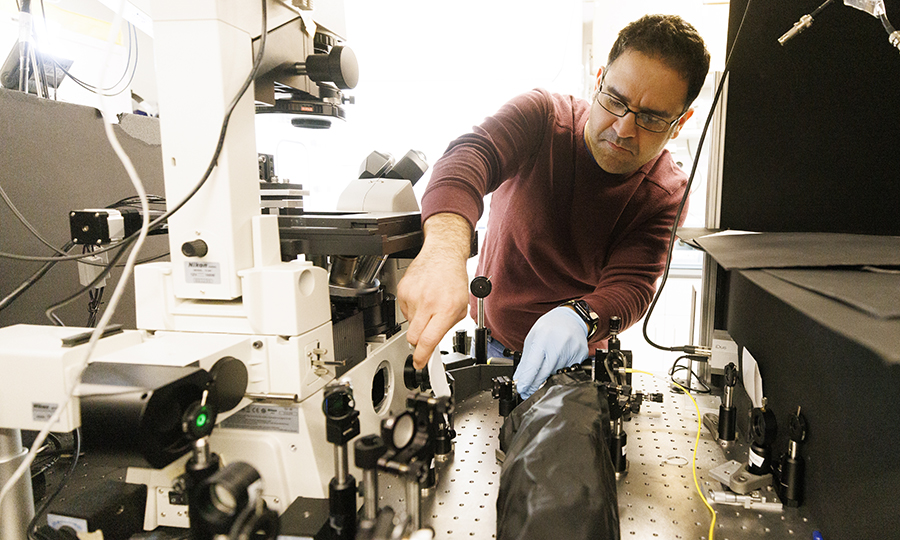Calendar Icon
Jul 06, 2023
Person Bust Icon
By Karl Vogel
![]() RSS
Submit a Story
RSS
Submit a Story

A pair of multidisciplinary teams with many of the same researchers are developing processes that allow scientists to better see into the nanoscale and harness possibilities of the quantum realm.
The two projects each had papers published in prestigious research journals in the same week of May and include faculty and graduate student researchers from several University of Nebraska-Lincoln academic departments – mechanical and materials engineering, electrical and computer engineering, chemistry, physics and astronomy.
Each team is supported by the National Science Foundation-funded Emergent Quantum Materials and Technologies (EQUATE) center, a state of Nebraska-sponsored cohort of 20 faculty from across multiple institutions for research that “guides discoveries and expedites findings of new emergent quantum materials and phenomena.”
“The multidisciplinary approach works for these projects because it allows us all to focus on one aspect that is vital to its success,” said Abdelghani Laraoui, assistant professor of mechanical and materials engineering and a researcher on both teams. “These projects are advancing what is possible for quantum research.”
ACS Nano

The May 9 edition of ACS Nano featured a paper in which the authors detail their novel technique using nitrogen vacancy (NV)-based magnetometry to study the magnetic properties of individual iron-triazole spin crossover nanorods and nanoparticle clusters.
Previous studies on these magnetic molecules were primarily conducted on a bulk format (solution or powder), making it difficult to study their individual magnetic behavior due to their weak stray magnetic signal.

Researchers drop-casted iron triazole nanoparticles on a diamond substrate doped with ultrasensitive quantum sensors. When a beam of green light is shot across the substrate, the NVs fluoresce a red light at varying rates in the presence of the nanorods and nanoparticles.
This change in fluorescence illuminates the area and allows an ultrahigh-resolution camera, as a function of the applied magnetic field, microwave frequency, and temperature, to trace the iron-triazole spins at the individual nanoparticle level.
Laraoui said the team’s research shows this technique improves imaging capabilities to below 20 nanometers (nm) – roughly 5,000 times smaller than a human hair – and perhaps sensitivity to as low as 10 nm.
By using a “thermal switch” and “permanent magnet,” Laraoui said, the team was able to control the spin states of individual nanorods and regulate both their levels of magnetism and the stray magnetic fields they create. These stray fields are very weak and make it more difficult to measure using traditional techniques, such as magnetic force microscopy.
“Any molecule has components, including transition metals such as iron, which are magnetic, and those components’ spin behave differently, depending on the temperature,” Laraoui said. “At lower temperature, the spins have no magnetic signal because they cancel each other out.
“You can control this not only with temperature and a magnetic field, but with voltage applied in ways that switch the spins of magnetic molecules.”
Laraoui said the NV technique will allow studying of unexplored magnetic and physics phenomena at the nanometer scale and likely will lead to breakthroughs in quantum sensing, molecular spin electronics, and fields of medicine, such as virology and brain science research.
This team includes:
- Nebraska faculty: Abdelghani Laraoui, assistant professor of mechanical and materials engineering; Rebecca Lai, associate professor of chemistry; Sy-Hwang Liou, professor of physics and astronomy; Yinsheng Guo, assistant professor of chemistry; and Ilja Fescenko, from the laser center at the University of Latvia.
- Nebraska graduate students: Suvechhya Lamichhane (physics and astronomy), Kayleigh McElveen (chemistry), Adam Erickson and Rupak Timalsina (mechanical engineering); and chemistry postdoctoral researcher Shuo Sun.
Advanced Optical Materials
Researchers on the second team used an emerging, ultrathin host material to increase the brightness of single-photon emitters by 200 percent. Their paper was published in the May 3 edition of Advanced Optical Materials.
Hexagonal boron nitride (hBN), similar to graphene in that it is so thin it is considered practically two-dimensional, has become a highly desirable element for integrated quantum photonic networks. However, the low quantum efficiency of hBN-hosted quantum light – aka single-photon emitters (SPEs) – is a challenge.
Laraoui’s team focused its studies on single-photon properties of hybrid nanophotonic structures that are composed of SPEs and silver nanaocubes that host collective excitations of electrons (plasmons).
The Nebraska researchers showed that when an hBN flake is in direct contact with plamonic silver nanocubes, a strong and fast single photon emission of light at room temperature creates a two-times greater enhancement of the SPE’s fluorescence lifetime and intensity.
“These strong and fast SPEs obtained at room temperature can be very useful to various emerging applications in quantum optical communications and computing,” Laraoui said. “If you want to quantify the quantum photonics network or improve quantum communications, now you can control the properties.
“The results prove that room-temperature, solid-state quantum emitters in hBN or other two-dimensional van der Walls materials can be ideal platforms for integrated quantum photonics.”
This team includes:
- Nebraska faculty: Abdelghani Laraoui, assistant professor of mechanical and materials engineering; Sy-Hwang Liou, professor of physics and astronomy; Ufuk Kilic, research assistant professor of electrical and computer engineering; and Christos Argyropoulos, associate professor of engineering at Penn State and a former Nebraska Engineering faculty member
- Post-doctoral researcher: Mohammadjavad Dowran (mechanical engineering)
- Graduate students: Andrew Butler (electrical engineering), Adam Erickson (mechanical engineering), and Suvechhya Lamichhane (physics and astronomy)
Submit a Story